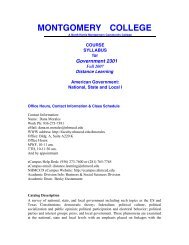2008 - Communication Across the Curriculum (CAC)
2008 - Communication Across the Curriculum (CAC)
2008 - Communication Across the Curriculum (CAC)
You also want an ePaper? Increase the reach of your titles
YUMPU automatically turns print PDFs into web optimized ePapers that Google loves.
C l i n i c a l A n a l y s i s<br />
that cannot be taken away – that makes life meaningful and<br />
purposeful.” (Frankl, 1959) With <strong>the</strong> proper guidance, help, and<br />
information regarding resources, <strong>the</strong> same may be said about<br />
patients and <strong>the</strong>ir caregivers.<br />
An active life serves <strong>the</strong> purpose of giving man <strong>the</strong> opportunity<br />
to realize values in creative work, while a passive life of<br />
enjoyment affords him <strong>the</strong> opportunity to obtain <strong>the</strong> fulfillment in<br />
experiencing beauty, art, or nature. But <strong>the</strong>re is also purpose in<br />
that life which is almost barren of both creation and enjoyment<br />
and which admits of but one possibility of high moral behavior:<br />
namely, in man’s attitude to his existence, an existence restricted<br />
by external forces. A creative life and a life of enjoyment are<br />
banned to him. But not only creativeness and joyfulness are<br />
meaningful. If <strong>the</strong>re is meaning in life at all <strong>the</strong>n <strong>the</strong>re must be a<br />
meaning in suffering. Suffering is an ineradicable part of life, even<br />
as fate and death. Without suffering and death human life cannot<br />
be complete. –Victor E. Frankl (Frankl, 1959)<br />
Assessment of <strong>the</strong> caregiver’s adjustment to <strong>the</strong>ir new role<br />
is vital. Some questions that <strong>the</strong> nurse can keep in mind<br />
while interacting with <strong>the</strong> caregiver are as follows:<br />
- Does <strong>the</strong> caregiver recognize <strong>the</strong> need for personal time<br />
- How much rest does <strong>the</strong> caregiver get<br />
- How does <strong>the</strong> caregiver find time for privacy and time to<br />
get personal errands done<br />
- How much time does <strong>the</strong> caregiver have away from <strong>the</strong><br />
client<br />
- What alternatives for client care has <strong>the</strong> caregiver made in<br />
order to provide private time<br />
- How does <strong>the</strong> caregiver cope with demands<br />
- What value does <strong>the</strong> caregiver see to home care<br />
- What kind of lifestyle changes has <strong>the</strong> caregiver made<br />
- Are <strong>the</strong>se changes realistic and feasible<br />
- How does <strong>the</strong> caregiver allow for flexibility in routine<br />
(Stolte, 1994)<br />
Caregiver Burden Scale<br />
(Rate each statement on a scale of 0 [not true] – 4 [very true] )<br />
1. I feel that my (relative) makes requests of me<br />
that are over and above what he/she needs.<br />
2. Because of my involvement with my<br />
V o l u m e I V : F a l l 2 0 0 8<br />
7 4






